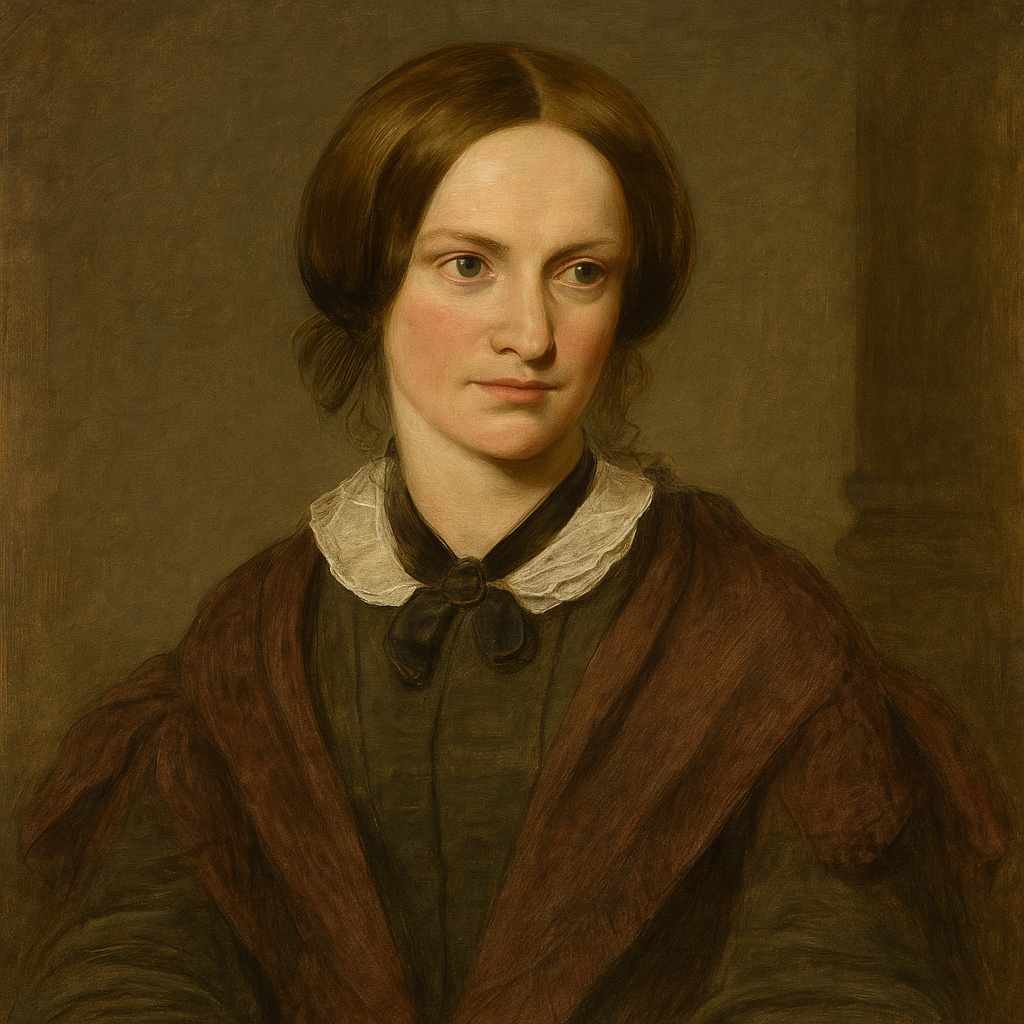Life
Charlotte Brontë
1816 to 1855

Life, believe, is not a dream
So dark as sages say;
Oft a little morning rain
Foretells a pleasant day.
Sometimes there are clouds of gloom,
But these are transient all;
If the shower will make the roses bloom,
O why lament its fall?
Rapidly, merrily,
Life’s sunny hours flit by,
Gratefully, cheerily,
Enjoy them as they fly!
What though Death at times steps in
And calls our Best away?
What though sorrow seems to win,
O’er hope, a heavy sway?
Yet hope again elastic springs,
Unconquered, though she fell;
Still buoyant are her golden wings,
Still strong to bear us well.
Manfully, fearlessly,
The day of trial bear,
For gloriously, victoriously,
Can courage quell despair!
Charlotte Brontë's Life
Introduction
Charlotte Brontë's poem "Life" presents a nuanced exploration of human existence, blending optimism with a realistic acknowledgment of life's challenges. This concise yet profound work, composed in four stanzas of varying lengths, offers a compelling perspective on the nature of life, death, and the human spirit. Through a careful examination of its structural elements, imagery, and thematic content, we can uncover the layers of meaning embedded within this deceptively simple poem.
Structural Analysis
The poem's structure is noteworthy for its irregularity, which mirrors the unpredictable nature of life itself. The first two stanzas consist of eight lines each, while the third and fourth stanzas are composed of four lines. This asymmetry creates a sense of movement and progression, reflecting the poem's central theme of life's ever-changing nature.
The rhyme scheme varies throughout the poem, with the first two stanzas following an ABABCDCD pattern, while the shorter stanzas adopt an AABB structure. This shift in rhyme scheme coincides with a change in tone and focus, moving from broader philosophical statements to more specific exhortations.
The meter of the poem is predominantly iambic, with lines alternating between tetrameter and trimeter. This rhythmic pattern creates a musical quality that enhances the poem's uplifting message. The use of shorter lines in the third and fourth stanzas increases the tempo, conveying a sense of urgency and enthusiasm.
Imagery and Symbolism
Brontë employs rich natural imagery throughout the poem, drawing parallels between the cycles of nature and the human experience. The "morning rain" in the third line serves as a metaphor for life's early difficulties, which often give way to brighter prospects. This image is further developed in the second stanza, where the "shower" that makes "the roses bloom" symbolizes the transformative power of adversity.
The contrast between light and dark is a recurring motif in the poem. The "clouds of gloom" are juxtaposed with "Life's sunny hours," emphasizing the transient nature of both joy and sorrow. This interplay of light and shadow reflects the poem's central argument that life is neither entirely bleak nor consistently bright, but rather a complex intermingling of both elements.
The personification of hope as a resilient figure with "elastic springs" and "golden wings" in the fourth stanza is particularly striking. This vivid imagery conveys the idea of hope as an indomitable force, capable of rebounding from setbacks and elevating the human spirit.
Thematic Analysis
At its core, "Life" is a meditation on the nature of human existence and our response to its inherent challenges. The poem's opening lines directly challenge the pessimistic view of life as a "dream / So dark as sages say," setting the stage for a more balanced and ultimately optimistic perspective.
Brontë acknowledges the presence of difficulties and sorrows in life, represented by the "clouds of gloom" and the intrusion of Death who "calls our Best away." However, she consistently emphasizes the transient nature of these hardships, encouraging the reader to maintain a broader, more hopeful outlook.
The poem's central argument is that life's value lies not in the absence of struggle, but in our ability to face adversity with courage and resilience. This theme is particularly evident in the final stanza, where the speaker exhorts the reader to bear "The day of trial" with manful fearlessness, asserting that courage can "quell despair."
Philosophical Underpinnings
Brontë's poem reflects a philosophical stance that aligns with elements of Stoicism and Christian thought. The emphasis on accepting life's trials and finding meaning in the face of adversity echoes Stoic teachings on virtue and resilience. Similarly, the poem's hopeful outlook in the face of death and sorrow resonates with Christian concepts of faith and redemption.
However, "Life" is not merely a reiteration of established philosophical or religious doctrines. Brontë's perspective is distinctly humanistic, focusing on the innate strength of the human spirit rather than divine intervention. The poem suggests that the power to overcome life's challenges lies within ourselves, in our capacity for courage, hope, and perseverance.
Literary Context
To fully appreciate "Life," it is crucial to consider its place within the broader context of Brontë's work and the literary landscape of the 19th century. The poem's themes of resilience and the human spirit's triumph over adversity are recurrent in Brontë's novels, particularly in "Jane Eyre."
The optimistic tone of "Life" stands in contrast to the often bleaker outlook of many of Brontë's contemporaries, such as the melancholic poetry of Emily Brontë or the social critiques of Charles Dickens. This divergence highlights Charlotte Brontë's unique voice and her commitment to exploring the full spectrum of human experience, including moments of joy and triumph.
Linguistic Analysis
Brontë's choice of language in "Life" is deceptively simple, yet carefully crafted to convey complex ideas. The use of monosyllabic words in key phrases such as "Life's sunny hours flit by" creates a sense of immediacy and accessibility, while more complex vocabulary is employed to express abstract concepts like "elastic springs" of hope.
The poem's diction shifts subtly between stanzas, moving from a contemplative tone in the opening lines to a more forceful, imperative voice in the final stanza. This progression mirrors the poem's thematic movement from observation to exhortation, culminating in a call to action for the reader.
Brontë's use of alliteration, such as "Rapidly, merrily" and "Gratefully, cheerily," enhances the poem's musical quality and reinforces its uplifting message. The repetition of adverbs ending in "-ly" in the shorter stanzas creates a sense of momentum and enthusiasm, urging the reader to embrace life's joys and challenges alike.
Conclusion
Charlotte Brontë's "Life" is a masterful exploration of the human condition, offering a nuanced perspective on the nature of existence that remains relevant to contemporary readers. Through its careful balance of form and content, vivid imagery, and philosophical depth, the poem presents a compelling argument for embracing life in all its complexity.
The enduring appeal of "Life" lies in its ability to acknowledge the reality of human suffering while simultaneously affirming the power of hope, courage, and resilience. Brontë's poem serves as a testament to the human spirit's capacity to find meaning and joy in the face of adversity, offering a timeless message of encouragement and inspiration.
In its concise yet profound examination of life's dualities – joy and sorrow, light and darkness, hope and despair – "Life" exemplifies the power of poetry to distill complex philosophical ideas into accessible and emotionally resonant verse. As such, it stands as a significant contribution to the canon of English literature, worthy of continued study and appreciation.
This text was generated by AI and is for reference only. Learn more
Want to join the discussion? Reopen or create a unique username to comment. No personal details required!



Comments
No comments yet. Be the first to comment!